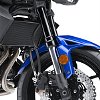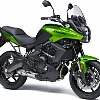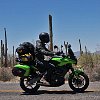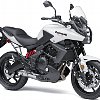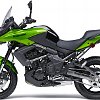The Kawasaki Versys has somewhat of a cult following. Like its dual-sport brother, the KLR650, it's a bike whose owners absolutely swear by it and act as if they've found riding nirvana.
I rode 3,000 miles on a 2014 Kawasaki Versys 650 ABS in the last month. So did it convince me to give up everything else?
The bike

At a curb weight of 460 pounds, it’s actually fairly light for its class. The Suzuki V-Strom 650 and Honda NC700X both come in at around 470 pounds. With a seat height of 33 inches, the Versys requires a long reach to the ground, but its slender frame and light weight make it feel the lightest of the three.
The Versys’ 17-inch tires reduce unsprung weight and, when paired with class-leading 25-degree front rake, help make for a very nimble motorcycle. Kawasaki’s condensing of the front allowed the use of a slightly longer swingarm, which helps keep the Versys stable at higher speeds.

Stopping power is delivered by dual, 300mm, petal-style discs with two-piston calipers up front and a single disc at the rear. With ABS now standard, braking is improved, though it still feels unresponsive. The brakes will stop you when you need them to, but if you're used to the brakes on sportier, modern motorcycles, the Versys binders could give you a pretty good scare the first time you use them.
The Versys comes with a five-gallon gas tank and returned an average of about 40 mpg, depending on how long I rode flat out into a windstorm. Under ideal conditions and lower speeds, 50 mpg is possible, but when we were battling fierce winds on our ride to Arizona, I was looking for gas after 160 to 170 miles. I wouldn’t call that typical riding, however.

Testing the Versys
I rode a 2014 Kawasaki Versys 650 ABS for almost 2,500 miles in three weeks. A great deal of that was on a road trip to southern Arizona, which included long stretches of incredibly windy freeway, massive elevation changes, and twisty mountain roads. We even rode a little dirt, but considering how our bikes were packed down with gear, I can’t really say I can speak to its off-pavement abilities.
I also used the bike a great deal commuting around the greater Los Angeles area. On the downside, that means lots of crazy drivers, the worst asphalt you’ve ever seen, pedestrians who like to jump into the street, lane splitting, and a freeway system that is an 85 mph free-for-all. On the positive side, it also means long stretches of the Pacific Coast Highway, wide and perfectly asphalted Orange County byways, and lots of twisty canyon roads on the weekends.
Especially when it first came out, some people looked at the Versys and judged it on the basis of things it was never meant to be. It is not a big adventure-touring bike, designed for riding around the world (although some owners have ridden it to Ushuaia anyway). It is not a big dual-sport, designed to do equal duties on and off the road. It is not a small motorcycle with capabilities that limit it to around-town duties and tiny stints on the freeway. It is a one-stop shop if you want to be able to accomplish a wide range of street riding and enjoy yourself doing it, while acknowledging you aren’t using the most sophisticated tool for the job.

The highlights
The test bike was equipped with the optional color-matched saddlebags that are made by Givi and sold by Kawasaki dealers. On top of that, I added far too much gear for a five-day trip with some buddies, but the Versys still hustled into headwinds at a respectable — though gas-guzzling — pace. Even when challenged with a 6,000-foot ascent up Mount Lemmon, it neither complained nor felt tapped out. While I could feel the extra weight slogging from side to side (the result of strapping bags onto bags onto more bags), both the engine and suspension rose to the occasion and delivered dependable performance, albeit a slower one than had I been riding sans gear.
Around town, the slender weight and frame, combined with the sporty 17-inch wheels and adept suspension, made for a very agile motorcycle. Side-to-side transitions were quick and precise, and the Versys felt quite planted. The 17-inch wheels, which carry 120mm-width and 160mm-width tires front and rear, respectively, in many ways define the Versys, separating it from adventure-touring bikes that may look similar but feel different and provide different capabilities. In addition to the nimble handling, the 17-inch wheels give you a wide choice of street-oriented rubber and very few dirt-oriented options.
The Versys has a fairly compact rider triangle. The reach to the bars is relatively short and the foot pegs place your feet ever so slightly back, under your body. This encourages you to sit slightly leaned forward, beneficial for high-speed winds or sporty riding. At 6 feet, 1 inch tall, I found the peg position perfect for hustling the bike up and down Mount Lemmon or Ortega Highway, which made any knee fatigue I felt after a long day of riding completely worth it.
The powerband on the Versys is absolutely fantastic given its relatively small displacement. The low end is sufficient to keep you from kicking yourself for letting the revs fall too low and blowing your drive out of a corner, and the mid to top end is an absolute blast to play in. On many comparable bikes, I’d set my corner entry speed and try to maintain it through the turn with slight acceleration at the end. On the Versys, I was able to attack corners like I would on a naked bike, adjust on the fly, and really power through.
Styling is the most subjective issue, so you'll make up your own mind, but personally, I’m a huge fan of the looks. I appreciate Kawasaki sending me the Kawi-green version for photos, but it’s the white one with the red Showa shock spring that really tugs at my heart. I saw one leaving Kawi HQ, complete with a fender eliminator kit, and thought to myself, "I could see myself owning that bike."

The lowlights
Weaknesses have to be viewed in light of the price point, but the first thing I would upgrade on the Versys would be the brakes. I’ve definitely ridden worse, even on bikes released this year, but the Versys just didn’t provide the feel or stopping power I need to feel comfortable. I would imagine some steel-braided brake lines and better pads would help.
I also found the gearbox to be a bit clunky. I thought it might just be that Kawasaki had given me a brand new one, just hours after its break-in service, but after talking to a few colleagues I discovered they had similar problems. It wasn’t that I necessarily thought I was going to break the bike or damage it, but it just didn’t have that smooth operation I’m used to from the Japanese brands.
Lastly, seeing as how the Versys shares so much with the Ninja 650, I would like to see the instrument panel from the Ninja on the Versys. No reason not to include things likes a miles-until-empty counter if you already have it.
The competition
The two main competitors for the Kawasaki Versys are the Honda NC700X and the Suzuki V-Strom 650. At $7,999, the Kawi is comparable to the $7,799 Honda and slightly cheaper than the $8,299 Suzuki.
Power wise, the Versys comes out on top. It is even with the V-Strom on horsepower and significantly ahead of the Honda’s 51 hp. Torque for all three comes in around 41-43 foot-pounds, depending on whose dyno you believe.
The Versys feels like the smallest of the three bikes, despite actually having the tallest seat height. The Honda has an incredibly low center of gravity, but still feels noticeably heavier than the Versys, and the Suzuki feels bigger in every capacity. The Honda does benefit, however, from being lower to the ground and is therefore less intimidating for new riders.
Initially, I was in love with the Honda. Its overall fuel economy and that storage compartment really won me over. However, after the release of the Honda CB500X, I actually preferred the 500 for its diminutive size and ease of use for around-town riding.
The V-Strom would be my pick if I planned on seeing more dirt or if a larger percentage of my riding was long-distance. Its larger size makes it more comfy for the long haul and the adventure version comes with massive panniers. Wrap that 19-inch front wheel in some TKC80s and you have quite the true adventure bike, but around town I would prefer the agility of the Versys any day.

The conclusion
When Kawasaki issued the first-generation Versys in 2008, they explained that the somewhat awkward name is a mash-up of "versatile system," and while it may not roll easily off the tongue, the name is apt.
Sometimes, when companies try to create a product with versatility in mind, they end up with something that isn’t really good at anything. The Kawasaki Versys is the antithesis of that. In fact, I’m almost embarrassed to admit that it’s my favorite motorcycle they make currently. It is 5 percent to 10 percent better than I thought it would be in nearly every capacity and, for $8 grand, is one hell of a bargain.
So much so that I recently encouraged my friend, Josh, who came on our Arizona adventure, to buy one as his first motorcycle. TeamZilla Editor Lance Oliver, who was riding motorcycles before I was born, has a Versys fitted with saddlebags that he uses for long-distance trips. Professional stunt rider Jason Britton rides a Versys as his daily rider. When one bike can meet the varied needs of such a diverse group of new and experienced riders, that says something about its versatility.
Have a Versys? What is your favorite thing about it? Decide to go with one of its competitors? Tell us why.































 Riders Preferred Membership
Riders Preferred Membership


